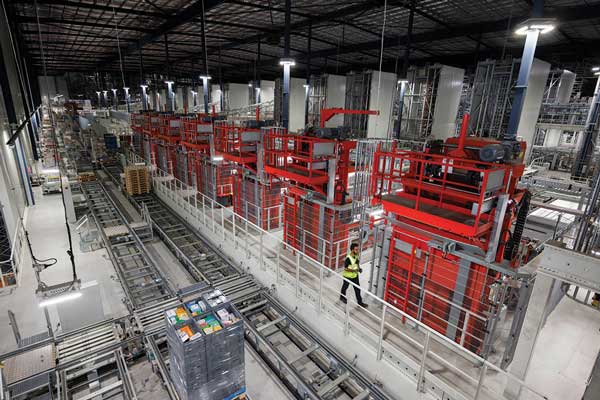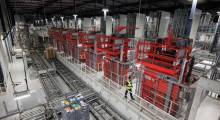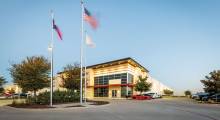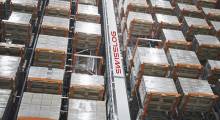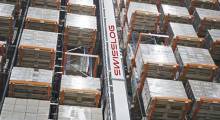Coles Supermarket
- Location:Redbank, Queensland, Australia
- Size: 710,000 square feet (66,000 square meters)
- SKUS: 18,500
- Goods handled: Ambient grocery goods
- Throughput: Up to four million cases per week
- Shifts: 2 shifts per day/6.5 days per week
Check out the full System Report for the new Coles' Distribution Center
Coles Redbank ADC for ambient goods is highly automated when it comes to the majority of the case volume it sends to stores, with some manual pick to pallet activity for a small percentage of goods, and some semi-automated picking of small items. There is also manual truck unloading and loading using lift trucks.
Receiving
Most deliveries arrive on gondola style trucks to the main receiving area (1), which is covered by a large canopy with 18 unload positions. Using manually operated lift trucks, working from the sides of the gondola, two pallets are unloaded at a time, and placed on nearby pallet conveyor that moves goods into the building. There are also seven docks for rear unload trailers.
Automated storage
Once inside the building, a quality control area checks for overhang on pallets and verifies pallet weights and case quantities. The loads, including the shipping pallets, are then placed on a system pallet for the high-bay automated storage and retrieval (AS/RS), and travel into the AS/RS (2) on one of two automated infeed conveyors. The high-bay warehouse has 16 pallet cranes and 65,000 pallet locations.
Car Picking System
Next to the high-bay, a semi-automated, storage and order picking system is used for picking large or bulky cases like big bundles of paper towels, or dog food, to pallets. It has four aisles, with automated replenishment from the high-bay, and pick faces are ground level, where operators on a pallet rider with double-deep forks pick goods to pallet with the help of a voice picking system. Known as the Car Picking System or (CPS) area (3), it handles about 4% of volume, and has its own stretch-wrap equipment, and conveyance out to the dispatch buffers.
The tray warehouse
Based on demand from stores, pallets are retrieved from the high-bay warehouse and conveyed to two depalletizing areas (4), where the stretch wrap is “defoiled” or removed, the pallets are delayered, the cases are placed on conveyor and singulated. The cases are conveyed to tray/merge area, where they slide onto a system tray, and travel into the tray warehouse (5), which consists of 80 mini-load AS/RS.
Sequencing and palletizing
The tray warehouse and its cranes automatically retrieve cases when needed to fill orders and by conveyor, the trays and goods move to the sequence buffers (6). These buffers hold and deal out cases in the sequence needed for the specific store builds. Each sequence buffer feeds its own palletizing automation cell, a Witron Case Order Machine (COM) that lifts and slides cases into the position to automatically build up a store-optimized or route-optimized load. Once built, a pallet load is conveyed to one of four orbital stretch wrappers (7), wrapped, labeled, and then conveyed to one of the dispatch buffers. The OPMs typically process 65% to 70% of weekly case flow.
Small-item picking
The All in One (AIO) system (8) is used to pick small items like health and beauty products to totes. Incoming goods are decanted from pallets into system totes in an adjacent decant area, then move into the AIO. The tote-handling system has 16 cranes and 32 workstations at which team members pick items into order totes aided by pick-to-light instructions. The area has its own tote stacking, palletizing, stretch wrapping and labeling functions.
Shipping
The dispatch buffers (9) are where completed pallets are staged for outbound shipment. The buffers use eight pallet cranes to automatically store pallets in racking, then lower them to the shipping (10) dock area, where the outbound pallets are loaded by manually operated lift trucks onto rear-opened trailers, at one of 72 dock positions.
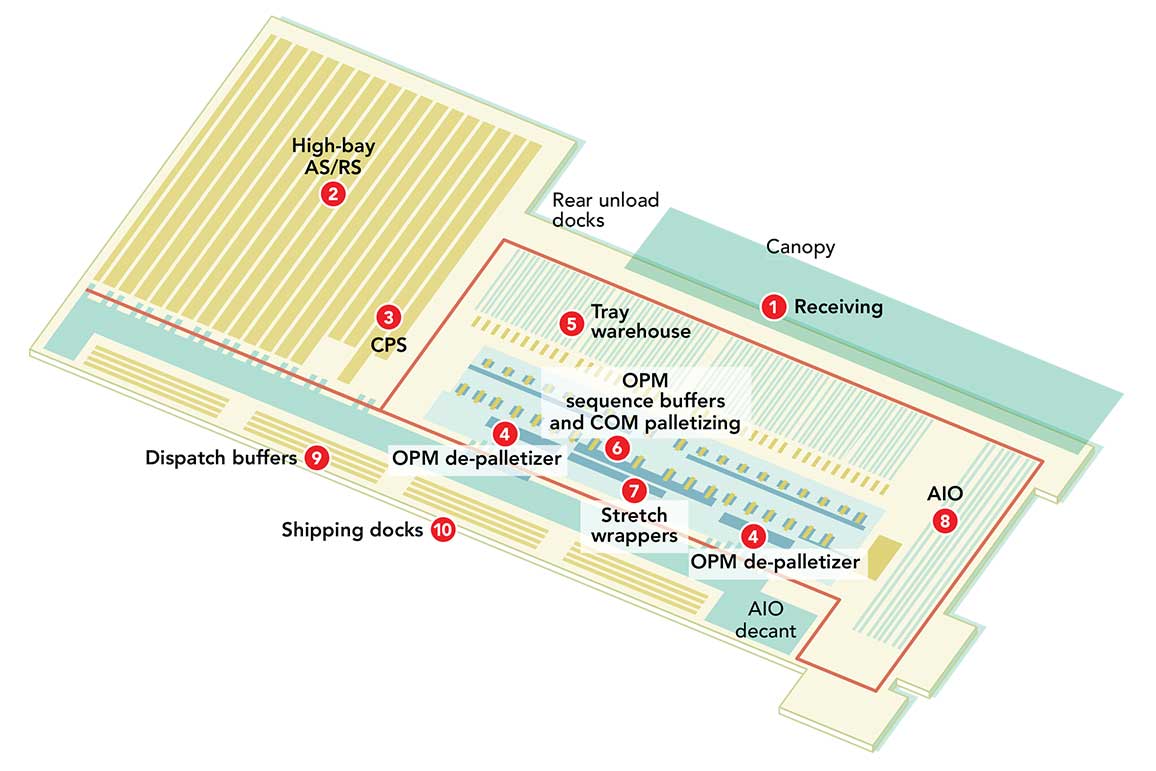
System suppliers
- Design/Integration: TMX Transform
- System design, Integration, Pallet AS/RS, Mini-Load AS/RS, Automated Palletizing, Warehouse Managemetn and Control Systems: WITRON
- Depalletizers: Riantics
- Strechwrappers: Strema
- Lift Trucks: Toyota Material Handling
Article topics
